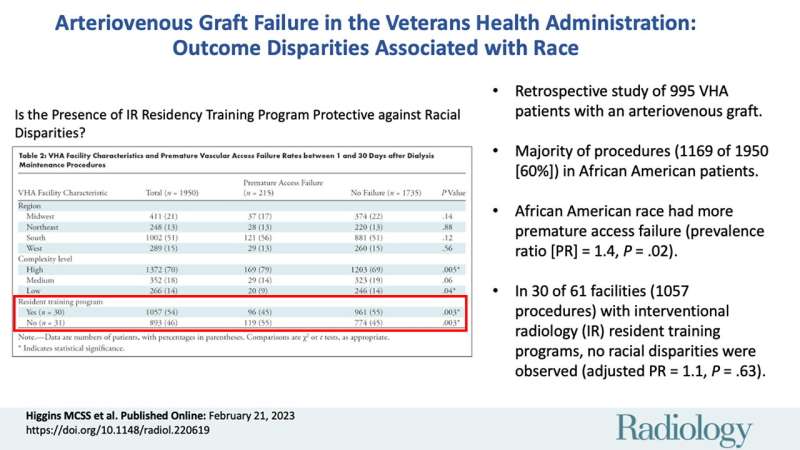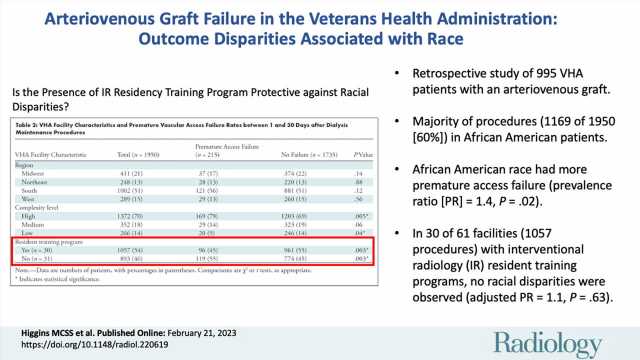
Compared to other races, African American patients are more likely to experience premature arteriovenous (AV) graft failure in the treatment of advanced kidney failure, according to a study published today in Radiology.
Chronic kidney disease affects roughly 37 million U.S. adults, according to the Centers for Disease Control and Prevention. Over time, chronic kidney disease can result in kidney failure.
One treatment option for advanced kidney failure is hemodialysis, or dialysis, where a machine outside the body filters a patient’s blood when the kidney can no longer accomplish this function. To aid with dialysis treatment, physicians need to create access to the bloodstream by installing either an AV fistula, catheter or an AV graft.
An AV graft is the placement of a flexible tube to create a path between an artery and a vein. While AV fistulas are the preferred method for dialysis access, some patients may need to receive an AV graft when their veins are too small or weak for a fistula.
“Patients with renal failure often receive an AV graft to facilitate dialysis,” said study co-author Hillary J. Mull, Ph.D., M.P.P., an investigator for the Center for Healthcare Organization and Implementation Research for the VA Boston Healthcare System in Massachusetts, and associate professor of surgery at Boston University Chobanian & Avedisian School of Medicine.
“These grafts can fail over time, requiring an interventional radiologist to perform a maintenance procedure. If the procedure has a complication within 30 days, the patient will need another procedure right away to fix the problem.”
Prior studies have found racial and ethnic disparities in the treatment of chronic kidney disease and dialysis access. Additionally, women and minority populations are more likely to receive AV grafts rather than other forms of grafts that are less likely to have complications.
“The literature has clearly illustrated higher rates of access failure with AV grafts, as well as the disappointing disparities in outcomes for African Americans undergoing dialysis access interventions,” said the study’s lead author Mikhail C.S.S. Higgins, M.D., M.P.H., assistant professor from the Department of Radiology at Boston University Chobanian & Avedisian School of Medicine.
To identify the racial disparities among premature AV graft failures, researchers used medical data from the Veterans Health Association (VHA).
In this retrospective cohort study, researchers identified 1,950 AV graft procedures in 995 patients (mostly men) across 61 VHA facilities. The average age of the patients was 69 years. Most of the procedures (60%) involved African American patients and patients residing in the southern portion of the U.S (51%). A majority of the procedures were performed by interventional radiologists.
Premature graft failures occurred in 11% of the procedures. After controlling for a variety of factors, such as socioeconomic and comorbidities, African American race was associated with premature graft failure.
“African American patients are more vulnerable to experiencing early dialysis access dysfunction and failure when compared to their other racial counterparts. This relative predisposition to this complication represents a disparity in care and adverse outcomes in a largely understudied population, namely the VHA system,” Dr. Higgins said.
Out of the 61 VHA facilities included in the study, 30 of them had interventional radiology resident training programs, which had lower rates of premature graft failure. Notably, there was no evidence of racial disparities in the outcome of the 1,057 procedures that were conducted in facilities with an interventional radiology resident training program. However, the researchers stress that the association between facilities with teaching programs and health outcomes should be further studied.
“We cannot say that patients should find hospitals with teaching programs, as our results do not show this direct relationship,” Dr. Mull said. “Rather, teaching is associated with equitable patient outcomes for dialysis access maintenance procedures and there are likely unmeasured factors associated with teaching programs that influence this relationship.”
According to Dr. Higgins, the results of this study suggest that there are environmental and cultural characteristics of teaching sites that help to reduce racial disparities in patient care and health outcomes.
The researchers believe that future studies should investigate the occurrence of graft failures in non-VHA populations as well as other factors, such as provider, facility, and regional practices, that reduce racial disparities in premature graft failure.
More information:
Mikhail C. S. S. Higgins et al, Arteriovenous Graft Failure in the Veterans Health Administration: Outcome Disparities Associated with Race, Radiology (2023). DOI: 10.1148/radiol.220619
Journal information:
Radiology
Source: Read Full Article
